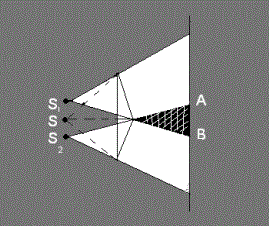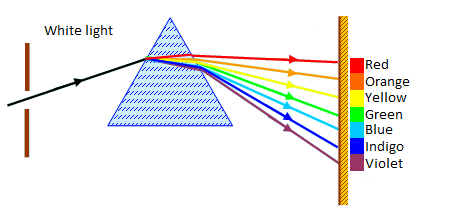Light is electromagnetic radiation that is perceived by the human eye. The human eye detects electromagnetic waves with wavelengths ranging from 380 to 760 nanometers (nm).
The short-wavelength boundary is typically considered to be the range of 380-400 nm (790-750 THz), while the long-wavelength boundary is 760-780 nm (up to 810 nm) (395-385 THz).

| Red | 650-760 nm |
| Orange | 590-650 nm |
| Yellow | 530-590 nm |
| Green | 490-530 nm |
| Blue | 450-490 nm |
| Indigo | 420-450 nm |
| Violet | 380-420 nm |
In physics, the term “light” has a somewhat broader meaning and is synonymous with optical radiation, encompassing the infrared and ultraviolet regions of the spectrum.
The study of light falls within the branches of physics such as optics and spectroscopy, and the measurement of light intensity is known as photometry (light flux, luminance, illuminance, and so on).
How Light is Generated
Light is an electromagnetic wave, emitted by charged particles in motion, and these particles are part of the composition of matter’s atoms. In order for the atoms of matter to emit light, they must acquire energy from an external source, achieved by either heating the substance or exposing it to radiation.
By gaining excess energy, an atom transitions to an excited state, which it can maintain for about 10-8 seconds before it expends the excess energy by emitting radiation. Therefore, strongly heated objects emit light, and their illumination is explained by the radiation of electromagnetic waves with wavelengths ranging from 380 to 760 nm. Each substance emits only a specific set of wavelengths, distinct from others.
This occurs because the atoms of matter can exist in discrete energy states, each corresponding to a specific energy level. Light emission happens when an atom transitions from a higher-energy state to a lower-energy state. The energy difference is carried by the emitted wave. This emission process is finite in time, approximately t = 10-8 seconds, and the wave emitted by an atom can be represented as a small part of a sine wave. This part of the sine wave has a length of l = c ∙ t, where l = 3 ∙ 108 m/s ∙ 10-8 = 3 meters, and it is called a wave packet. The emission of these wave packets occurs simultaneously from a large number of matter’s atoms independently of each other. We perceive such a flow of wave packets as light.
Sources of Light
A source of light is an object that emits electromagnetic radiation (light) into the surrounding space. A source of light is considered point-like if its dimensions can be neglected compared to the distance from the observation point.
There are natural and artificial sources of light.
- Natural sources include those provided by nature itself, such as the Sun, stars, lightning, the Northern Lights, bioluminescent insects, and some plants.
- Artificial sources are those created by humans, such as lamps, candles, bonfires, spotlights, luminaires, and others.
Depending on the temperature, we also distinguish between thermal and fluorescent light sources.
- Thermal sources include the Sun, candles, gas torches.
- Fluorescent sources include television screens, computer monitors, fluorescent and LED lamps, certain living organisms, and the Northern Lights.
Light Phenomena
Dispersion of Light
Dispersion of light is the phenomenon of spectral decomposition of non-monochromatic radiation into its component parts by frequency (or wavelength – λ).
The reason for this decomposition is the dependence of the speed of light in a medium on frequency (or wavelength).
The speed of light in a medium υ is given by υ = c / n, where n is the refractive index of the medium, and c is the speed of light in a vacuum (299,792,458 meters per second).
One of the most vivid examples of dispersion is the separation of white light when it passes through a prism (Newton’s experiment). The essence of the dispersion phenomenon lies in the unequal propagation speed of light rays with different wavelengths in an optical medium (light has the same speed in a vacuum, regardless of its wavelength). Typically, the higher the frequency of the wave, the higher its refractive index in the medium, and the lower its speed of propagation in that medium. In the long-wavelength (red) region of the spectrum, light has a higher speed in the medium and a lower degree of refraction, whereas in the short-wavelength (violet) region of the spectrum, the speed of light in the medium is lower, and the degree of refraction is higher.
Interference of Light
Interference of light is a common property of waves of any nature, where waves overlap with each other, resulting in the reinforcement or cancellation of resulting oscillations, depending on the point in space.
To obtain a stable interference pattern, it is necessary for the composing waves to be coherent. Coherent waves are those with the same frequency (period) and a constant phase difference in time. To achieve coherent waves, it is necessary to “split” the light wave from a single source into two or more waves. After traveling different paths, these waves, having a certain path difference, interfere.
The scheme of obtaining interference using a Fresnel biprism.
The wave coming from the light source splits due to the refraction of light in the two halves of the biprism. The resulting waves 1 and 2, as if emanate from two imaginary sources S1 and S2, and are coherent. Therefore, interference is observed in the shaded region. An interference pattern is observed on the screen at segment AB.

Diffraction of Light
Diffraction of light is the phenomenon of bending of light waves around various opaque obstacles. The phenomenon of diffraction is explained by Huygens-Fresnel principle: each point on the wavefront serves as a source of secondary waves, which is the fundamental factor that determines the intensity of light at any point in space.
The condition for observing diffraction is:
r ≥ d² / λ
where:
r – distance from the screen to the obstacle
d – size of the obstacle
λ – wavelength of the light.
Geometric Optics (Propagation of Light)
This is a branch of optics that studies the propagation of light. Since the wavelengths perceived by the eye are small, the propagation of visible light can be considered without considering its wave nature. Then, the direction of wave propagation can be determined using rays – lines perpendicular to the wavefronts.
Geometric optics is based on four laws:
Law of Rectilinear Propagation of Light
In an optical homogeneous medium, light propagates in a straight line.
Law of Reflection
The incident and reflected rays, as well as the perpendicular drawn to the boundary of two media at the point of incidence, lie in the same plane. The angle of incidence α is equal to the angle of reflection β.
Law of Refraction
The incident and refracted rays, as well as the perpendicular drawn to the boundary of two media at the point of refraction, lie in the same plane. The ratio of the sine of the angle of incidence to the sine of the angle of refraction γ is a constant for the two media:
sin α / sin γ = n
where n is the relative refractive index of the second medium with respect to the first.

